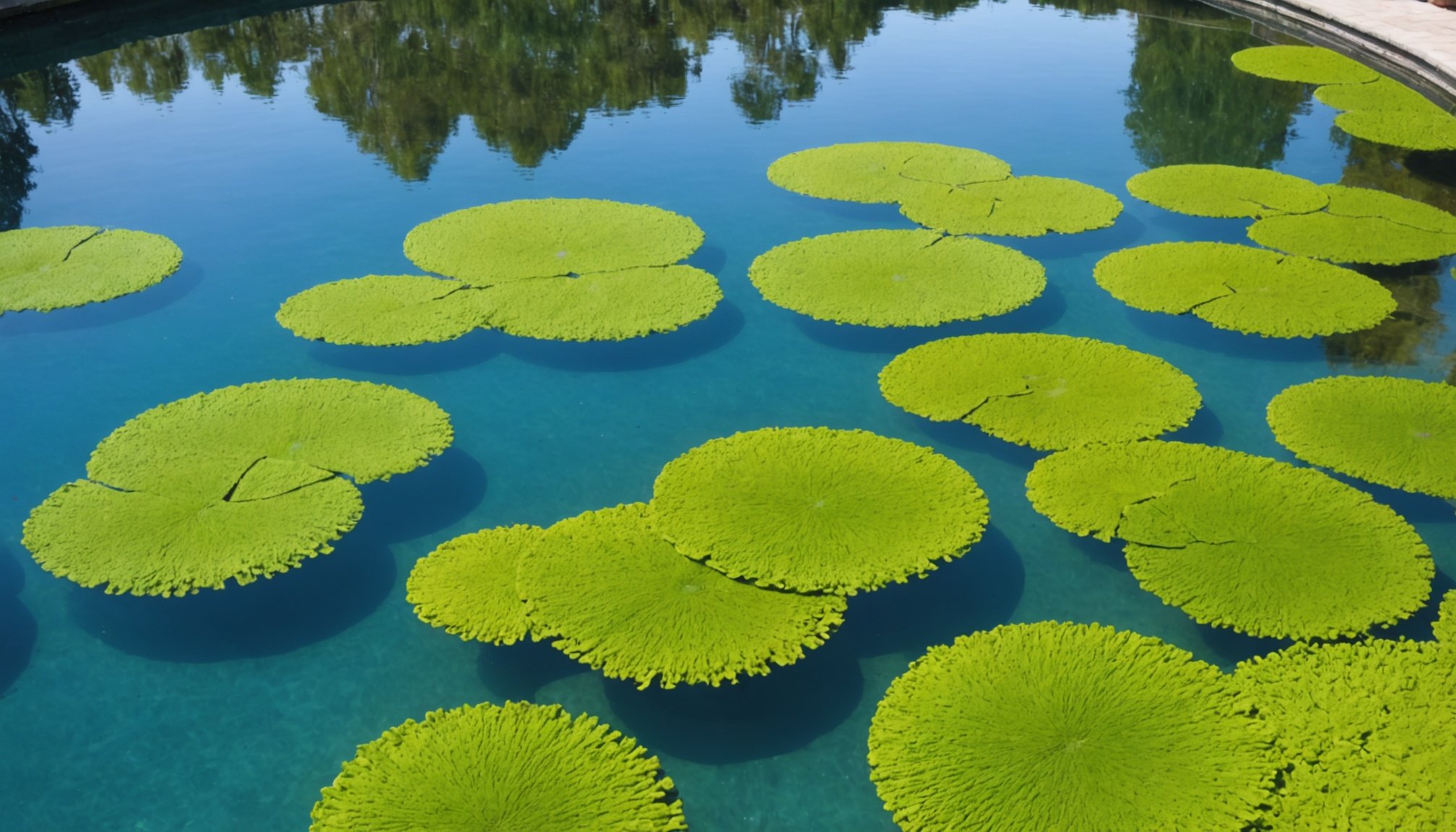Algae growth in swimming pools is a common concern for many pool owners. These unwelcome guests can turn your clear blue water into an unsightly green mess, making your pool uninviting. Understanding how to manage algae effectively is crucial for maintaining a clean and safe swimming environment. In this article, we will explore the causes of algae growth, how to prevent it, and the effective treatments you can use to eliminate it. With the right approach, you can keep your pool sparkling clean and chlorine levels balanced throughout the swimming season.
Understanding Algae Growth in Pools
Algae are simple, plant-like organisms that thrive in moist environments, making swimming pools the perfect breeding ground. When conditions are right, algae can multiply rapidly, leading to green, murky water. The primary factors that contribute to algae growth include inadequate chlorine levels, poor water circulation, and lack of proper filtration.
Also to read : How can you install a swimming pool fence that meets UK regulations?
The three main types of algae that you may encounter in your pool are green, black, and mustard algae. Green algae are the most common and often appear as a green film on the water’s surface. Black algae are more stubborn and can attach themselves to the surface of your pool, making them harder to eliminate. Mustard algae, resembling yellowish-brown spots, can also be resistant to standard treatments.
If you notice your pool turning green, don’t panic. Understanding the underlying causes will help you take the right actions to restore your pool. The water temperature, sunlight exposure, and the presence of organic debris can all affect algae growth. By ensuring that your pool’s water chemistry is balanced and that its filtration system is functioning correctly, you can significantly reduce the likelihood of algae blooming.
Also to read : How can you create a relaxing atmosphere around your home swimming pool?
Regularly testing your pool’s water for pH and chlorine levels will provide valuable information on its condition. Ideally, you want to maintain a chlorine level between 1 and 3 parts per million (ppm) and pH levels between 7.2 and 7.8. Keeping these levels in check will help prevent algae from taking hold.
Preventive Measures to Keep Your Pool Algae-Free
Preventing algae growth is much easier than treating an existing problem. Adopting a proactive maintenance routine can help you keep your pool clean and inviting. Here are some essential steps to consider:
Regular Filtration: One of the best ways to keep algae at bay is to ensure that your pool’s filter is functioning optimally. Good filtration helps to remove debris that can serve as a food source for algae. Run your filter for at least 8-12 hours a day, especially during peak swimming season.
Maintain Balanced Water Chemistry: Regularly check and adjust your pool’s water chemistry. Testing kits can help you monitor pH and chlorine levels to prevent imbalance. A well-balanced pool is less likely to suffer from algae growth.
Use Algaecide as a Preventive Measure: Adding an algaecide to your pool care routine can fight off algae before it becomes a problem. These chemicals work by disrupting the cell structure of algae, making it difficult for them to survive. Follow the manufacturer’s instructions for effective use.
Skim and Brush Regularly: Debris like leaves and twigs can accumulate in your pool, providing a breeding ground for algae. Skim the surface daily and brush the sides and bottom of your pool weekly to remove any algae spores or organic materials.
Keep Your Pool Covered: When not in use, consider covering your pool. A cover will keep debris out and limit sunlight penetration, both of which can contribute to algae growth.
Adopting these preventive strategies can significantly reduce your chances of encountering algae problems. By taking these steps, you ensure your pool remains a refreshing oasis for you and your guests.
Effective Treatments for Existing Algae Problems
Even with the best preventive measures in place, you may still find yourself dealing with algae growth. If your pool has turned green, here are systematic steps to effectively treat and eliminate the problem:
Shock Your Pool: Start by shocking your pool with a high dose of chlorine. This treatment will help kill existing algae and other contaminants. Depending on the severity, you may need to add 1-3 times the normal amount of chlorine. Make sure to follow the instructions on your shock treatment product.
Vacuum and Brush: After shocking, thoroughly brush the walls and floor of your pool to loosen any algae clinging to surfaces. Use a manual or automatic vacuum to remove the dead algae and debris from the bottom of the pool. Pay special attention to corners and steps, where algae tend to accumulate.
Add Algaecide: Following the initial shock treatment, use an algaecide specifically formulated for the type of algae you are dealing with. This will help to ensure that any remaining spores are eradicated. Ensure that the pump is running to circulate the chemicals effectively.
Monitor Water Chemistry: After treating your pool, continuously monitor the water chemistry. You will want to maintain proper chlorine levels and check the pH balance. It may take several days for the pool to clear up completely, so patience is key.
Keep Filtering: Allow your filter to run continuously until the pool is clear. This helps remove any remaining debris and dead algae from the water. As the water clears, you will notice the color returning to a crystal-clear blue.
With careful attention and the right steps, you can turn your green pool back into a clean and inviting space. Be diligent in your efforts, and soon, the only thing you’ll need to worry about is enjoying a refreshing swim.
Long-Term Maintenance for a Healthy Pool
Managing algae is not just about treating the symptoms; it’s about establishing a routine that fosters a healthy swimming environment. Long-term maintenance is crucial for preventing future algae outbreaks. Here are some practices to implement:
Regular Cleaning Schedule: Develop a cleaning schedule that includes skimming, brushing, and vacuuming your pool regularly. Make it a habit to check your pool’s water levels, and adjust them as needed. A little bit of regular work can go a long way in keeping algae at bay.
Consistent Use of Chemicals: Incorporate regular doses of chlorine and algaecide into your maintenance routine. You can set reminders to test and balance your pool’s water chemistry every week. This consistency will help you stay ahead of any potential algae growth.
Use Quality Pool Equipment: Invest in high-quality pool maintenance tools, including filters, pumps, and skimmers. Ensure that your equipment is appropriate for the size of your pool and is functioning effectively. An efficient filtering system is essential for keeping your pool water clean and clear.
Seasonal Maintenance: In addition to regular upkeep, seasonal maintenance is essential. Before opening your pool for the season, conduct a thorough inspection and cleaning. Similarly, when closing your pool for winter, take the necessary steps to prepare it for the colder months to prevent algae from developing during periods of inactivity.
By implementing these long-term maintenance strategies, you will create an environment that is less conducive to algae growth. A well-maintained pool not only enhances your swimming experience but also ensures the longevity of your pool.
Managing algae growth in your swimming pool might seem daunting, but with the right knowledge and tools, you can effectively keep your pool clean and inviting. By understanding the causes of algae, implementing preventive measures, and knowing how to treat existing problems, you will enjoy a refreshing swimming experience without the hassle of algae. Remember, consistency in maintenance is key to achieving and maintaining a beautiful pool. With diligence and care, you can ensure your pool remains a source of enjoyment and relaxation for years to come.











